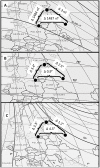Migratory Reed Warblers Need Intact Trigeminal Nerves to Correct for a 1,000 km Eastward Displacement
- PMID: 23840374
- PMCID: PMC3694148
- DOI: 10.1371/journal.pone.0065847
Migratory Reed Warblers Need Intact Trigeminal Nerves to Correct for a 1,000 km Eastward Displacement
Abstract
Several studies have shown that experienced night-migratory songbirds can determine their position, but it has remained a mystery which cues and sensory mechanisms they use, in particular, those used to determine longitude (east-west position). One potential solution would be to use a magnetic map or signpost mechanism like the one documented in sea turtles. Night-migratory songbirds have a magnetic compass in their eyes and a second magnetic sense with unknown biological function involving the ophthalmic branch of the trigeminal nerve (V1). Could V1 be involved in determining east-west position? We displaced 57 Eurasian reed warblers (Acrocephalus scirpaceus) with or without sectioned V1. Sham operated birds corrected their orientation towards the breeding area after displacement like the untreated controls did. In contrast, V1-sectioned birds did not correct for the displacement. They oriented in the same direction after the displacement as they had done at the capture site. Thus, an intact ophthalmic branch of the trigeminal nerve is necessary for detecting the 1,000 km eastward displacement in this night-migratory songbird. Our results suggest that V1 carries map-related information used in a large-scale map or signpost sense that the reed warblers needed to determine their approximate geographical position and/or an east-west coordinate.
Conflict of interest statement
Figures



References
-
- Perdeck AC (1958) Two types of orientation in migrating starlings, Sturnus vulgaris L., and chaffinches, Fringilla coelebs L., as revealed by displacement experiments. Ardea 46: 1–37.
-
- Mewaldt R (1964) California sparrows return from displacement to Maryland. Science 146: 941–942. - PubMed
-
- Chernetsov N, Kishkinev D, Mouritsen H (2008) A long-distance avian migrant compensates for longitudinal displacement during spring migration. Curr Biol 18: 188–190. - PubMed
-
- Perdeck A (1983) An experiment on the orientation of juvenile starlings during spring migration: an addendum. Ardea 71: 255.
Publication types
MeSH terms
LinkOut - more resources
Full Text Sources
Other Literature Sources

